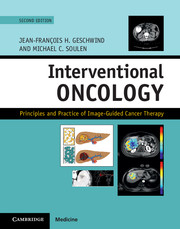Book contents
- Frontmatter
- Contents
- List of contributors
- Section I Principles of oncology
- Section II Principles of image-guided therapies
- Section III Organ-specific cancers – primary liver cancers
- 10 Assessment and triage of hepatocellular carcinoma
- 11 Image-guided ablation of hepatocellular carcinoma
- 12 Embolization of liver tumors: Anatomy
- 13 Conventional chemoembolization and chemoembolization with drug-eluting beads: Technique and future potential
- 14 90Yttrium radioembolization for hepatocellular carcinoma
- 15 Image-guided therapy of intrahepatic cholangiocarcinoma
- Section IV Organ-specific cancers – liver metastases
- Section V Organ-specific cancers – extrahepatic biliary cancer
- Section VI Organ-specific cancers – renal cell carcinoma
- Section VII Organ-specific cancers – chest
- Section VIII Organ-specific cancers – musculoskeletal
- Section IX Organ-specific cancers – prostate
- Section X Specialized interventional techniques in cancer care
- Index
- References
11 - Image-guided ablation of hepatocellular carcinoma
from Section III - Organ-specific cancers – primary liver cancers
Published online by Cambridge University Press: 05 September 2016
- Frontmatter
- Contents
- List of contributors
- Section I Principles of oncology
- Section II Principles of image-guided therapies
- Section III Organ-specific cancers – primary liver cancers
- 10 Assessment and triage of hepatocellular carcinoma
- 11 Image-guided ablation of hepatocellular carcinoma
- 12 Embolization of liver tumors: Anatomy
- 13 Conventional chemoembolization and chemoembolization with drug-eluting beads: Technique and future potential
- 14 90Yttrium radioembolization for hepatocellular carcinoma
- 15 Image-guided therapy of intrahepatic cholangiocarcinoma
- Section IV Organ-specific cancers – liver metastases
- Section V Organ-specific cancers – extrahepatic biliary cancer
- Section VI Organ-specific cancers – renal cell carcinoma
- Section VII Organ-specific cancers – chest
- Section VIII Organ-specific cancers – musculoskeletal
- Section IX Organ-specific cancers – prostate
- Section X Specialized interventional techniques in cancer care
- Index
- References
Summary
Introduction
Hepatocellular carcinoma (HCC) is the sixth most common cancer and the third leading cause of cancer-related death. Early diagnosis of HCC can be achieved by surveillance of at-risk populations. However, a careful multidisciplinary assessment of tumor characteristics, liver function, and physical status is required for proper therapeutic management even in patients with early-stage tumors. When surgical options are precluded, image-guided tumor ablation is recommended as the most appropriate therapeutic choice, and is considered a potentially curative treatment in properly selected candidates.
Several classification systems are available for HCC. The Barcelona Clinic Liver Cancer (BCLC) classification has emerged during recent years as the standard classification that is used for the clinical management of patients with HCC (Tables 11.1 and 11.2). This classification links stage stratification with a recommended treatment strategy and defines standard of care for each tumor stage. It has been endorsed by a European Association for the Study of the Liver (EASL) panel of experts and the American Association for the Study of Liver Diseases (AASLD) guidelines. Practices on HCC in Asia are somewhat different and the Asian Pacific Association for the Study of Liver recommendations and the recently published Hong Kong Liver Cancer (HKLC) staging system mirror current clinical practice in Asian countries.
According to the BCLC staging system, image-guided tumor ablation is recommended in patients with early-stage HCC. Radiofrequency ablation (RFA) has shown superior efficacy and greater survival benefit with respect to the seminal percutaneous technique, ethanol injection, in meta-analyses of randomized controlled trials (RCTs), and is currently established as the standard method for local tumor treatment.
In this chapter, image-guided ablation in very early and early-stage HCC is discussed, underlining the advantages and limitations of current locoregional treatments with respect to surgical approaches. Evolving methods, such as microwave ablation (MWA) and irreversible electroporation (IRE), will be described.
Very-early-stage hepatocellular carcinoma
In very-early-stage HCC the presence of a solitary small nodule, less than < 2 cm in diameter, in Child–Pugh A patients, and the absence of microvascular invasion and dissemination offers the highest likelihood of cure. According to the BCLC staging system – endorsed by the EASL and the AASLD – these patients can be offered surgical resection if they are non-cirrhotic or if they have cirrhosis but still have well-preserved liver function, normal bilirubin, and in the absence of clinically significant portal hypertension.
- Type
- Chapter
- Information
- Interventional OncologyPrinciples and Practice of Image-Guided Cancer Therapy, pp. 91 - 99Publisher: Cambridge University PressPrint publication year: 2016
References
- 3
- Cited by



